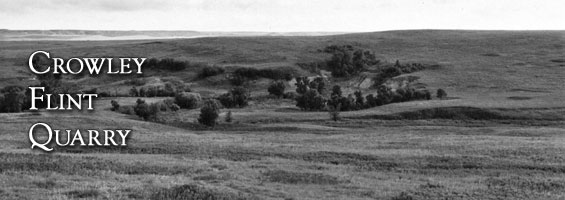We’ve launched a new web portal! Visit findhistory.nd.gov to search our collections.
Due to a road closure, the Killdeer Mountain Battlefield State Historic Site is temporarily closed.

For 11,000 years American Indians dug into gravel deposits in western North Dakota seeking Knife River flint, a coffee-colored, translucent stone. Knife River flint was easily made into tools for hunting game, preparing food, and many other purposes. Several of these ancient quarry pits are preserved at Crowley Flint Quarry State Historic Site, located near Golden Valley, Mercer County.
Knife River flint is one of the most important lithic (stone) materials used by prehistoric people in North America. Its attractive color, ability to hold a sharp edge, and easy procurement made it popular. Although the only major source of this stone is in North Dakota along Knife River and Spring Creek, artifacts made from Knife River flint have been found in archeological sites as far away as Pennsylvania. The flint reached these distant locations through trade. American Indians exchanged flint for other exotic goods, such as marine shells from the Gulf of Mexico, copper from the Great Lakes, or obsidian from the Yellowstone Park area.
At Crowley Flint Quarry, rounded holes mark the locations where Knife River flint was removed by prehistoric stone quarriers. Numerous depressions, measuring nine feet across and up to three feet deep, testify to the industry of these early peoples. The first Ice Age inhabitants of the state dug shallow pits in the loose glacial gravel and removed cobbles of the prized stone. Later, American Indians had to dig deeper to find suitable flint cobbles, because much of the best material had already been removed. Early in the first century A.D., digging Knife River flint was a well-organized activity. It was the predominant lithic material in the area until it was replaced by metal tools introduced by European traders.
Although Crowley Flint Quarry has not been excavated by archeologists, archeological excavations of similar sites have produced a wealth of information about North Dakota’s first natural commodity. Because Crowley Flint Quarry is surrounded by private land and lacks an access road, it is currently closed to the public.
SHSND Address:
612 East Boulevard Ave.
Bismarck, North Dakota 58505
Get Directions
SHSND Hours:
Museum Store: 8am - 5pm M-F; Sat. & Sun. 10am - 5pm.
State Archives: 8am - 4:30pm., M-F, except state holidays, and 2nd Sat. of each month, 10am - 4:30 pm.
State Historical Society offices: 8am - 5pm M-F, except state holidays.
Contact SHSND:
phone: 701.328.2666
email: history@nd.gov